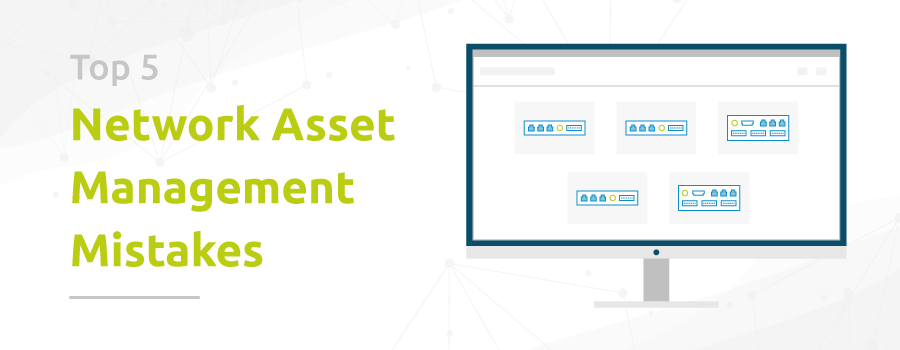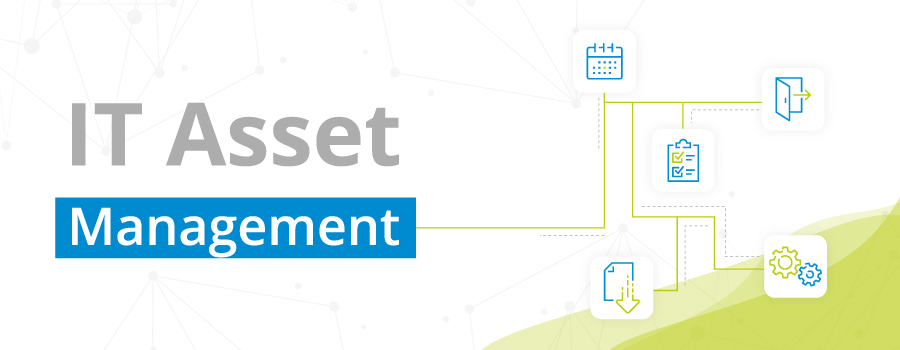Network Asset Management is a complex process that involves planning, lifecycle management, commissioning, operation, maintenance, repairs, configuration changes, replacement, and decommissioning activities. Thereby network asset management system is key for your business strategy.
Why Does Your Business Need Network Asset Management System?
There are several concerns affecting organizations such as the management of thousands of different devices, maintenance processes efficiency, prevention measures to avoid misfunctions, audits and cybersecurity concerns, among others.
A comprehensive network asset management system supports all critical operations enabling you to ensure information availability to make decisions, to control assets lifecycle, guarantee security and reduce costs and save your budget.
Our solution offers you the perfect tool to give support to all phases of your asset management

Planning
- Centralized system.
- Comprehensive inventory.
- Interoperability and scalability.
- Reports.
- Dashboards

Acquisition
- 360° view of assets.
- Reports and KPIs.
- Real-time and historical data.
- Available stock for replacements or repairs.

Operation
- Fault management and correlation.
- Asset integration.
- Automatic asset discovery.
- Inventory automation.
- Performance, lifecycle, and asset state management.

Maintenance
- O&M support.
- Field service consolidation.
- Configuration updates and management.
- Integration with other systems.

Renewal
- Statistics.
- Backup management.
- Stock management.
- Change and configuration monitoring.
What does our Network Asset Management System offer you (that others don´t)?
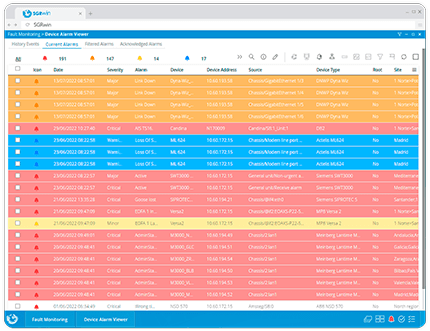
Fault Management and Root Cause Detection
You will be able to effectively monitor your network, detect, locate, correlate, and correct network faults. By using our tool it is easy to identify the root cause of problems due to accurate event processing and categorisation features.
Network Assets Configuration Management and Monitoring
Our solution enables you to monitor and manage configuration changes, offers you backup management and restoring options, massive operations launcher and asset integration tools.
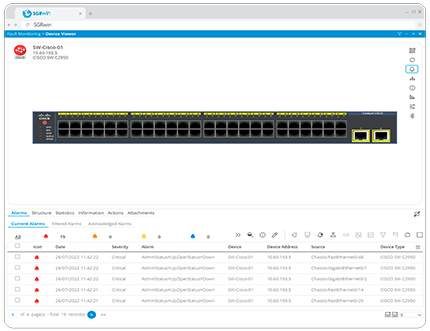
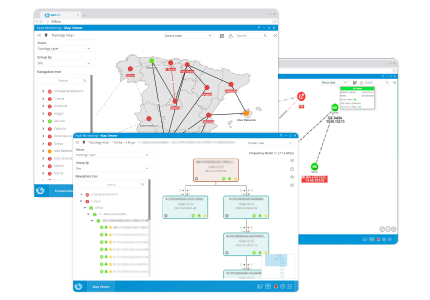
Custom views of your assets
Configure your network element views to include both managed and unmanaged components, using hierarchical levels such as topology, access, and transmission. Plus, real-time views are also available!
Network Assets Inventory
Complete inventory of your network assets is enabled. You will be able to analyse statistics and obtain useful information to manage your assets effectively.
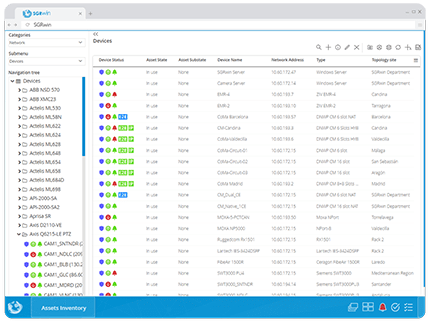
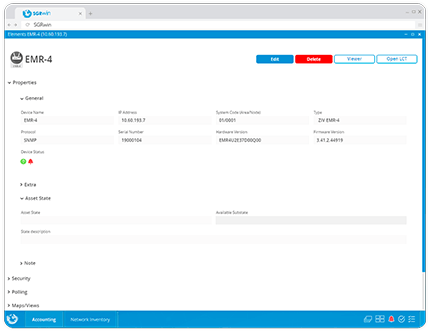
Asset status and utilization management
Our solution enables you to maintain complete control over your assets, monitoring their states and usage. You will be able to check asset statuses, stock information, executed updates, and other related data.
Asset Visualization and Management
By using our Asset Viewer you will be able to visualise assets’ details, states, documents attached and performance real-time information among other useful things.
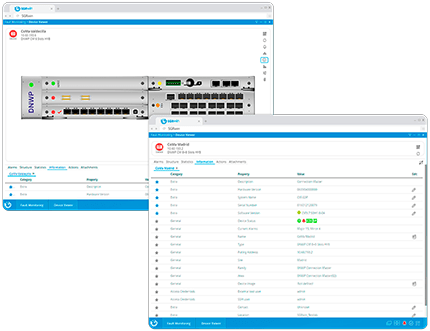
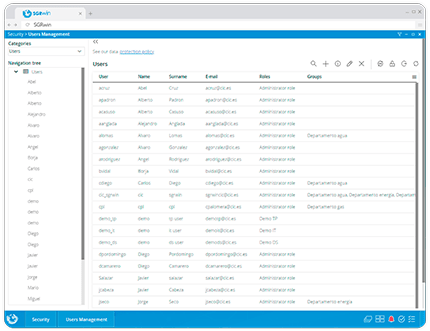
Security Management
Our tool enables you to avoid unauthorised acceses, control log activities, manage backup and configurations for disaster recovery processes, audit support, detect any deviation in your resources and view performance anomalies.
Why choose SGRwin for network asset management? What makes us different?

Improved assets life-cycle management bringing you relevant information about states, performance, and statistics.

Budgetary and maintenance costs savings avoiding significant revenue losses and high repair costs.

Greater visibility of your assets providing you a 360º view and advanced reports and repositories.

Increases security and gives you auditing support meeting regulatory compliance.

Assuring seamless management of legacy and new devices, getting rid of communication, connection, and discontinuity problems.

IT&OT convergence, enabling you to monitor and maintain all your network assets in one system.
Key Features
Assets faults collection, detection, correlation, and troubleshooting.
- Alarms and services monitoring (filters, acknowledge, suppression options are available).
- Alarm classification utilising colours to indicate the severity of the fault detected.
- Real-time events and correlation.
- Advanced maps.
- Service status monitoring.
- Notification management.
- Ticketing system integration.
- Root cause identification.
Next-level configuration management and monitoring at the click of a mouse.
- Configuration changes monitoring.
- Network assets autodiscovery.
- Management and integration tools for adding or removing equipment.
- Backup management and restoring options.
- Multi-vendor circuit provisioning.
- Configuration comparator.
- Massive Operation Launcher (massive software and firmware upgrades, configuration backups/restores, manufacturer scripts).
Monitor, manage and analyse your network assets inventory.
- Control and analyze your assets utilising useful information like Model, Serial number, HW/SW versions.
- Common inventory (Devices, Cards, Ports, SFPs, VLANs, Subnetworks, Servers, Edges, PLC’s, sensors etc.)
- Maps (Topology, Family, Access and Transmission Layers, IP, Customised maps, Areas, Stations, Connections, etc.)
- Circuits (PDH, SDH, MPLS-TP services, XC tables, tunnels, pseudo wires, EVCs, ECEs, etc.)
Extending lifecycle of your assets, optimising maintenance, and ensuring a proper performance.
- Configuration changes monitoring.
- Asset states (in order, in stock, in transit, in use, in maintenance, retired, missing, planned etc.).
- Stock information.
- Incidence records.
- Real-time and historical asset state.
- Advanced reports, dashboards and statistics based on your inventory.
Clear and concise assets visualisation and performance management.
- Detailed information about your assets (properties, actions, attachments etc.)
- Real-time statistics calculating assets’ health.
- Historical data and reports.
- Dynamic charts.
- Traffic monitoring (inbound and outbound).
Guaranteeing high-level security to manage you network assets for peace of mind.
- Log activity auditor.
- Prevention against unathorized accesses.
- Advanced performance reports.
- Compliance and auditing support.
- Back up management for disaster recovery.
Ready to discover?
Get your brochure here
